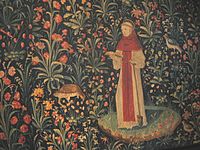Millefleur


Millefleur, millefleurs or mille-fleur (
There is also a rather different style known as millefleur in Indian carpets from about 1650 to 1800.
In the 15th century, an elaborate glass making technique was developed. See
Tapestries
In the millefleur style the plants are dispersed across the field on a green background representing grass, to give the impression of a flowery meadow, and cover evenly the whole decorated field. At the time they were called verdures in French. They are mostly flowering plants shown as a whole, and in flower, with the coloration of the flowers of a distinct brightness compared to the usually darker background. Many are recognizable as specific species, with varying degrees of realism, but accuracy does not seem to be the point of the depiction. Neither are the flowering plants used to create perspective or depth of field. There are very often animals and sometimes human figures dispersed around the field, often rather small in relation to the plants, and at a similar size to each other, whatever their relative sizes in reality.
The tapestries usually include large figures whose meaning is not always apparent, which seems to derive from the division of labour under the
Millefleur style was most popular in late 15th and early 16th century French and
The beginnings of the style may be seen in earlier tapestries. The famous
During the 1800s, the millefleur style was revived and incorporated into numerous tapestry designs by
-
À mon seul désir, from the set The Lady and the Unicorn, late 15th century
-
15th-century tapestry
-
Detail of one of the set The Lady and the Unicorn
-
Millefleurs in a heraldic tapestry for theBishop of Salzburg, after 1519
-
The Adoration of the Magi woven byMorris & Coin the late 1800s.
Indian carpets
The term is also used to describe north Indian carpets, originally of the late Mughal era in the late 17th and 18th century. However these have large numbers of small flowers in repeating units, often either springing unrealistically from long-ranging twisting stems, or arranged geometrically in repeating bunches or clusters. In this they are essentially different from the irregularly arranged whole plant style of European tapestries, and closer to arabesque styles. The flowers springing from the same stem may be of completely different colours and types. There are two broad groups, one directional and more likely to show whole plants (an early version is the upper illustration), and one not directional and often just showing stems and flowers.[6]
They appear to have been manufactured in Kashmir and present-day Pakistan. They reflect a combination of European influences and underlying Persian-Mughal decorative tradition, and a trend for smaller elements in designs.[7] The style, or styles, were later adopted by Persian weavers, especially for prayer rugs, up to about 1900.
Millefiori decoration uses the Italian version of the same word, but is a different style, restricted to glass.
-
India, Fragment of a Saf Carpet, an early example rather closer to the tapestry style
-
Millefleur 'Star-Lattice' carpet, 17th–early 18th century Mughal India, Christie's
Other appearances

The millefleur style is sometimes used liberally in
Millefleur are used in artist
See also
Notes
- ^ Egglezos, Panos (January 31, 2012). "How It's Made - Millefiori Glass Paperweights" (Video). How It's Made. Discovery Channel. Archived from the original on 2021-12-21. Retrieved March 21, 2019 – via YouTube.
- ^ Struble, Karen. "Millefleur glass paperweight ...and more!". Retrieved March 21, 2019 – via Pinterest.
- ^ Souchal, 108
- ^ Souchal, 117
- ^ Souchal, 108
- ^ Walker, 119–125
- ^ Walker, 119–125
- ^ Masson, Sophie (October 19, 2016). "2BR02B: the journey of a dystopian film–an interview with Leon Coward". Feathers of the Firebird (Interview).
References
- Souchal, Geneviève (ed.), Masterpieces of Tapestry from the Fourteenth to the Sixteenth Century: An Exhibition at the Metropolitan Museum of Art, 1974, Metropolitan Museum of Art (New York, N.Y.), Galeries nationales du Grand Palais (France), ISBN 0870990861, 9780870990861, google books
- Walker, Daniel (1997). Flowers underfoot : Indian carpets of the Mughal era. New York: The Metropolitan Museum of Art.
Further reading
- Cavallo, Adolph S., Medieval Tapestries in the Metropolitan Museum of Art, 1993, Metropolitan Museum of Art (New York, N.Y.), ISBN 0870996444, 9780870996443









